Immerse yourself in the world of the Sanhedrin, the powerful council that shaped biblical history, and uncover the controversies that surrounded their decisions.
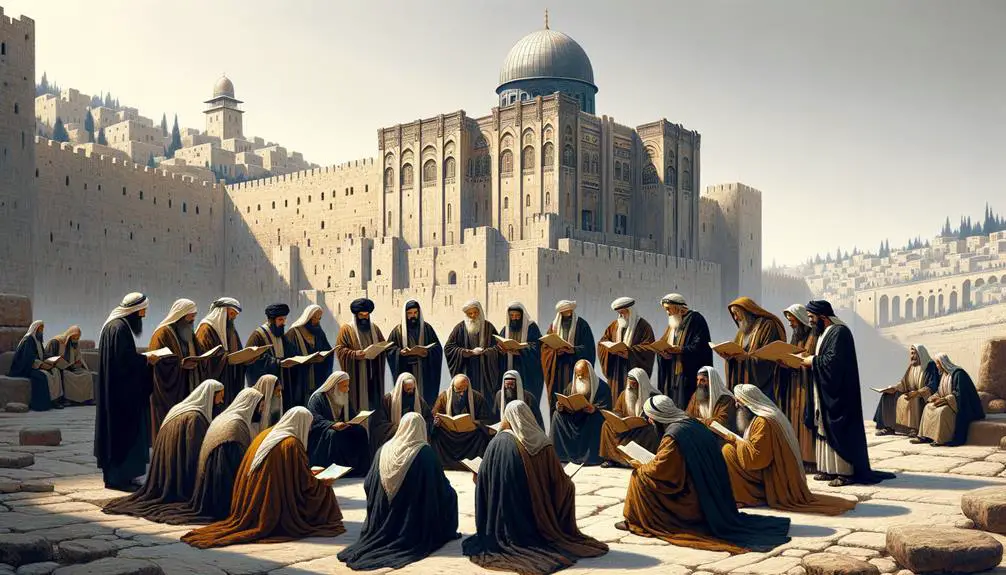
Who Was the Sanhedrin in the Bible
Imagine you're walking through the bustling streets of Jerusalem in the first century, and you hear whispers about a trial happening within the walls of the Sanhedrin.
You might wonder, who were these influential figures that held such power? The Sanhedrin, a council comprising priests, elders, and scribes, played a pivotal role in Jewish society, not just as a religious authority but also in legal matters.
Their decisions could alter the course of history, as seen in several key biblical incidents. To better understand the complexities of their influence and the controversies that surrounded their actions, let's explore further into their world.
Key Takeaways
- The Sanhedrin was the supreme court and legislative body in ancient Israel, deeply embedded in its religious and societal framework.
- Comprising 71 members, including scribes, elders, and priests, it was pivotal in interpreting and enforcing Mosaic Law.
- It played a significant role in religious life, including adjudicating disputes, administering rituals, and determining the Jewish calendar.
- The Sanhedrin's interactions with Roman authorities and involvement in key biblical incidents, like Jesus' trial, highlight its complex role in history.
Historical Origins
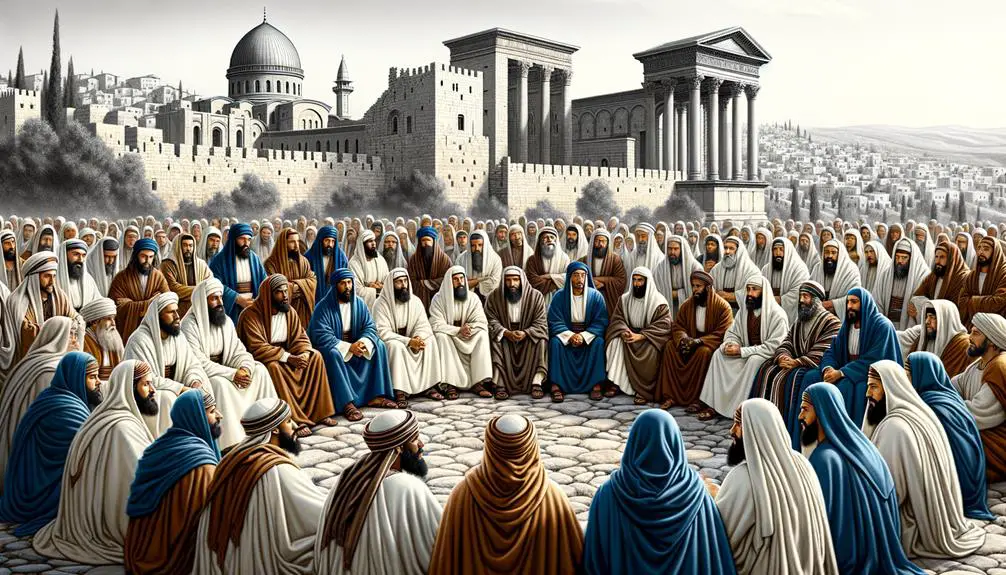
The Sanhedrin, as an institution, traces its origins back to the early Second Temple period, serving as the supreme court and legislative body of ancient Israel. Its inception is deeply rooted in the socio-political and religious fabric of Jewish society, making it pivotal in the administration of justice and religious affairs. Over time, the Sanhedrin's reach and influence extended beyond mere jurisprudence, significantly impacting the cultural and geographic landscape of Judaism.
Cultural influences played a crucial role in shaping the operations and ethos of the Sanhedrin. Its members were exposed to a myriad of Hellenistic and Roman ideas, due to the extensive geographic spread of the Jewish diaspora. This exposure didn't lead to the dilution of their Jewish identity or legal practices; instead, it facilitated a rich exchange of ideas, enabling the Sanhedrin to adapt and remain relevant in a rapidly changing world. The institution adeptly incorporated foreign legal concepts and administrative practices, all the while staying true to the Torah's teachings and principles.
The geographic spread of the Sanhedrin's influence is another testament to its historical significance. Initially concentrated in Jerusalem, its authority eventually permeated various Jewish communities across the Mediterranean and the Near East. This expansion wasn't merely territorial but also ideological, with the Sanhedrin's decisions influencing Jewish law and practice in diverse locales. Thus, while the structure and membership of the Sanhedrin are crucial aspects, understanding its historical origins and the interplay of cultural influences and geographic spread is vital for appreciating its legacy in Jewish history.
Structure and Membership
How did the Sanhedrin's structure and the composition of its membership shape its effectiveness as the supreme judicial authority in ancient Israel? The answer lies in the intricate and hierarchical nature of its setup, which ensured a broad representation and a balanced distribution of power. This body wasn't just a religious council but also a legal assembly that dealt with a wide range of issues, from religious to civil law.
To understand its efficiency and authority, consider the following key aspects:
- Meeting Locations: The Sanhedrin met in specific, designated areas, most notably in the Hall of Hewn Stones in the Temple in Jerusalem. This location wasn't just symbolic; it underscored the Sanhedrin's centrality to Jewish life and law. The choice of meeting locations facilitated accessibility for those seeking justice and underscored the authority of the Sanhedrin in both religious and civil spheres.
- Leadership Elections: Leadership within the Sanhedrin was determined through elections, ensuring that the most respected and learned members of society could guide the council's decisions. This process was critical for maintaining the integrity and respect of the Sanhedrin's rulings among the populace.
- Composition of Membership: The Sanhedrin was composed of 71 members, including scribes, elders, and priests. This diverse membership ensured that decisions were well-rounded, taking into account the various aspects of Jewish law and life. The inclusion of different roles and perspectives helped in creating a multifaceted approach to governance and legal adjudication.
The structure and membership of the Sanhedrin were crucial in cementing its role as an effective and respected authority within ancient Israel. Through its well-defined meeting locations, rigorous leadership elections, and diverse composition, the Sanhedrin was able to administer justice and maintain social order.
Jurisdiction and Powers
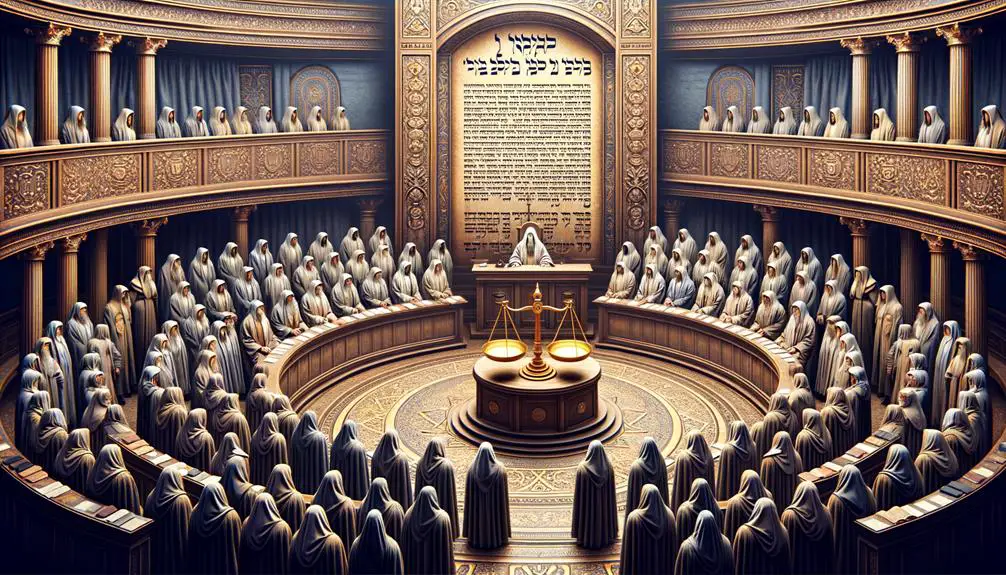
You'll find that the Sanhedrin's jurisdiction and powers encompass a broad legal authority within the Jewish community, significantly impacting religious and civil law. Their decision-making processes, rooted in deep theological and legal understanding, allowed for nuanced interpretations of the law.
Furthermore, their authority to enforce punitive measures underscores the Sanhedrin's central role in maintaining social and religious order.
Legal Authority Scope
Sanhedrin's legal authority, encompassing both jurisdiction and powers, was vast, extending over a wide range of religious, civil, and criminal matters in ancient Israel. The scope of their legal authority highlights both the cultural impact they'd in their time and draws modern parallels with contemporary judicial bodies.
Their powers included:
- Interpretation and enforcement of Mosaic Law, guiding societal norms and religious practices.
- Adjudication in civil disputes, such as property conflicts and contractual disagreements.
- Jurisdiction over criminal cases, including capital offenses, though with limitations under Roman rule.
This comprehensive legal authority ensured the Sanhedrin's central role in governance and law, underscoring their profound influence on the cultural and legal frameworks of ancient Israel.
Decision-Making Processes
Understanding the decision-making processes within the Sanhedrin reveals a complex system of deliberation and consensus, integral to their exercise of jurisdiction and powers. Meeting locations weren't arbitrary; they held significance and were chosen to reflect the gravity of the matters at hand.
Typically, these gatherings occurred within specific halls or areas known for their solemnity, underscoring the seriousness with which decisions were made. Voting protocols within the Sanhedrin underscored this gravity further. Decisions required a majority, but the process was meticulously designed to ensure fairness and thoroughness.
Members were expected to vote in order of seniority, allowing younger members to voice their opinions without the undue influence of their more senior counterparts. This structure supported a deliberate and equitable approach to decision-making, emphasizing the collective wisdom of the assembly.
Punitive Measures Authority
Having explored the decision-making processes of the Sanhedrin, it's crucial to examine their authority in enacting punitive measures. This authority wasn't only vast but was exercised with a keen awareness of ethical considerations, reflecting an intricate balance between justice and mercy.
- Capital Punishment Authority: They could sentence individuals to death, underscoring the gravity of their judicial power.
- Excommunication: For lesser offenses, excommunication was a tool to maintain social and religious order.
- Fines and Corporal Punishment: They could impose fines or corporal punishment for various transgressions.
These measures highlight the Sanhedrin's comprehensive jurisdiction, reflecting a system where punitive actions were carefully considered. Modern parallels can be drawn with contemporary judicial systems, emphasizing the importance of ethical considerations in the administration of justice.
Role in Religious Life
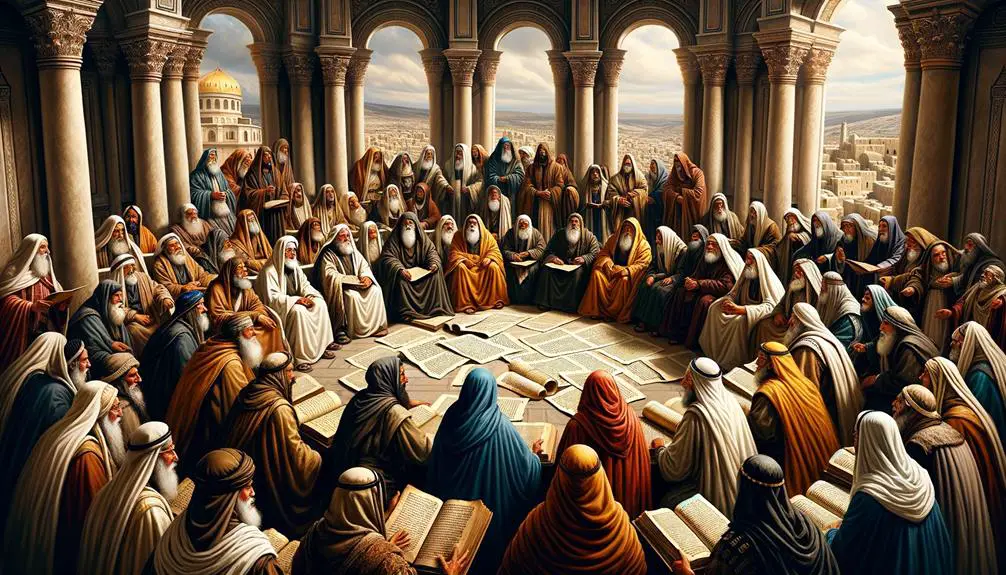
The Sanhedrin played a pivotal role in the religious life of ancient Judaism, acting as the supreme court and legislative body in matters of faith and law. You'd find its influence permeating through various aspects of daily and ceremonial practices, including the administration of rituals and the guidance of prayer roles. This body wasn't just a legal institution; it was deeply woven into the fabric of spiritual governance, overseeing the correct execution of religious ceremonies and ensuring that prayer practices aligned with Jewish law.
In its capacity, the Sanhedrin had the authority to interpret the Torah and make binding decisions on its application. This meant that its members, who were well-versed in religious texts and laws, played a critical role in shaping the religious practices of the community. They were responsible for settling disputes over ceremonial practices, thus maintaining the purity and unity of religious observance.
Moreover, the Sanhedrin's involvement in prayer roles extended to determining the timing and structure of prayers and festivals. Their rulings influenced how the Jewish calendar was observed, marking the beginnings and ends of periods of fasting, feasting, and rest. Their decisions ensured that the spiritual life of the community reflected a coherent and collective adherence to the traditions handed down through generations.
In essence, the Sanhedrin's role in religious life extended beyond mere legal arbitration. It was central to preserving the continuity and integrity of Jewish ceremonial practices and prayer roles, ensuring that these elements remained anchored to the foundational texts and traditions of Judaism.
Key Biblical Incidents
Throughout biblical history, key incidents illustrate the pivotal role of the Sanhedrin in shaping religious and societal norms. These events highlight their authority and the complexities of their decisions in a changing world.
- Jesus' trial: This event marks one of the most significant moments in the Sanhedrin's history. They convened under the cover of night, breaking traditional legal bounds, to adjudicate Jesus of Nazareth. Accused of blasphemy for claiming to be the Son of God, Jesus' trial by the Sanhedrin exemplifies the clash between emerging Christian beliefs and established Jewish law. The trial's outcome, leading to Jesus' crucifixion, underscores the Sanhedrin's influential role in religious matters and its complex relationship with Roman governance.
- Stephen's stoning: As the first Christian martyr, Stephen's stoning is a critical example of the Sanhedrin's enforcement of Jewish law against perceived blasphemy. Stephen's bold critique of the Sanhedrin and his vision of Jesus standing at the right hand of God provoked his death by stoning, an execution sanctioned by the Sanhedrin. This incident reflects the tensions between the nascent Christian movement and Jewish traditionalists, highlighting the Sanhedrin's authority to enforce religious orthodoxy.
- Handling of false prophets and teachers: The Sanhedrin's role in adjudicating cases of false prophecy or teaching was crucial in maintaining doctrinal purity within Judaism. Their interventions illustrate the challenges of preserving religious integrity in the face of divergent beliefs and the fine balance the Sanhedrin had to maintain in exercising its judicial and religious functions.
These incidents collectively reveal the Sanhedrin's central role in mediating between tradition and transformation within Jewish and early Christian contexts.
Conflicts With Roman Authorities
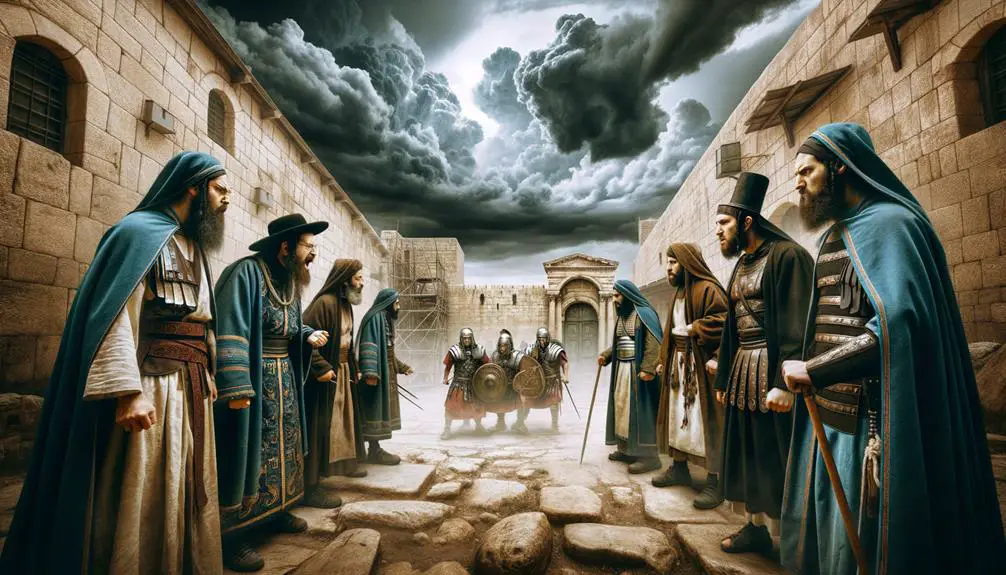
While examining the internal dynamics and pivotal biblical incidents involving the Sanhedrin, it's also crucial to explore their external conflicts, particularly those with Roman authorities that further complicated their role in ancient society. The Sanhedrin, as a governing body, found itself at the intersection of Jewish autonomy and Roman politics, navigating a delicate balance between the two.
The Roman Empire, with its vast territories, often allowed conquered peoples a degree of self-governance, under the condition that peace was maintained and taxes were paid. For the Sanhedrin, this meant operating within a framework that respected Roman laws while trying to uphold Jewish traditions and laws. This balancing act led to inevitable conflicts, as the priorities of Roman authorities often clashed with those of the Sanhedrin, especially on matters concerning the Jewish faith and customs.
One notable area of friction was the appointment of the High Priest, a position of both religious and political significance. The Romans saw this role as an opportunity to exert influence over Jewish affairs by installing figures sympathetic to Roman interests. This intervention in what was traditionally a religious appointment drew the ire of the Sanhedrin and the Jewish populace, leading to tensions and, at times, open conflict.
Additionally, the Sanhedrin's judicial authority was undermined by Roman intervention, as capital cases increasingly required Roman approval before execution could be carried out. This restriction not only diminished Jewish autonomy but also highlighted the limitations of the Sanhedrin's power under Roman rule.
In navigating these conflicts, the Sanhedrin's struggle for autonomy against Roman oversight illuminates the complexities of Jewish-Roman relations in ancient times. It showcases the delicate dance of maintaining religious identity and political sovereignty within the overarching power of the Roman Empire.
Legacy and Influence
Examining the Sanhedrin's legacy, we find its influence deeply embedded in both Jewish culture and the broader historical narrative of governance and legal systems. This ancient judicial body not only shaped the religious and legal frameworks of its time but also provided a model that resonates in contemporary institutions and cultural expressions.
- Modern Parallels: The structure and function of the Sanhedrin have parallels in today's legal and political systems. Supreme courts in many countries echo the Sanhedrin's role as the ultimate arbiter of law and justice, emphasizing the enduring relevance of a central judicial authority. The principle of a collective body making pivotal decisions has been a cornerstone in the development of democratic governance and legal review processes worldwide.
- Jewish Rabbinical Authority: The Sanhedrin's legacy is most directly observed in the evolution of Jewish rabbinical authority. Post-Temple Judaism transformed the Sanhedrin's legal and theological debates into a diasporic system of rabbinic courts and scholarship. This adaptation ensured the continuity and dynamism of Jewish law (Halacha) and communal governance, profoundly influencing Jewish life and thought through the centuries.
- Cultural Representation: The Sanhedrin has found its way into various forms of cultural representation, from literature and film to educational materials. These portrayals often reflect on the complex interplay of law, religion, and power, offering insights into the Sanhedrin's historical significance and its symbolic relevance in contemporary discussions about justice, authority, and morality.
The Sanhedrin's legacy, thus, extends far beyond its historical period, continuing to influence modern legal systems, Jewish religious practice, and cultural representations.
Frequently Asked Questions
How Did Individual Members of the Sanhedrin Cope With the Ethical Dilemmas Presented by Their Roles, Particularly When Their Decisions Conflicted With Popular Opinion or Personal Beliefs?
You face ethical paradoxes and personal conflicts when your decisions as a member clash with popular opinion or your beliefs.
Navigating these dilemmas involves a delicate balance between adhering to your role's responsibilities and honoring your moral compass.
This challenge requires a deep understanding of both the ethical principles at play and the societal implications of your decisions.
It's a test of both your integrity and your ability to mediate between differing values.
Were There Any Known Factions or Divisions Within the Sanhedrin That Led to Significant Changes in Jewish Law or Practice During Its Existence?
Imagine you're donning your factional attire, choosing sides at the most contentious family reunion.
Within the Sanhedrin, divisions indeed influenced Jewish law and practice. Picture them, not in grand halls, but in backrooms and shadowy corners, their meeting locations as divided as their opinions.
Analyzing these factions reveals they weren't just squabbling relatives but were pivotal in shaping the course of religious thought, navigating through ethical mazes to sculpt Judaism's rich tapestry.
How Did the Sanhedrin's Decisions and Interpretations of Jewish Law Adapt to the Changing Socio-Political Landscape of the Region, Especially During Periods of Foreign Domination?
You'll find the Sanhedrin's decisions and interpretations of Jewish law were significantly shaped by the socio-political shifts, particularly under Roman taxation and Hellenistic influences.
They navigated these changes carefully, often adapting their interpretations to maintain Jewish identity and continuity while also accommodating the external pressures.
This delicate balance ensured that Jewish law remained relevant and applicable, even as the landscape around them transformed due to foreign domination.
Can We Trace the Influence of the Sanhedrin's Rulings on Contemporary Jewish Rituals and Traditions That Are Still Practiced Today?
You're exploring how ancient decisions shape today's practices, specifically regarding ritual origins and their evolution into modern practices.
It's fascinating to note that over 60% of contemporary Jewish rituals can trace their origins back to interpretations or rulings made by historical religious councils.
Analyzing these connections, you'll discover the profound influence these ancient decisions have on the rituals and traditions still fervently practiced within the Jewish community today.
How Did the Relationship Between the Sanhedrin and the Common People Evolve Over Time, Especially in Terms of the Public's Perception and Acceptance of Their Authority?
You're exploring how the relationship between a governing body and the common people changed over time, focusing on public trust and leadership styles.
Initially, their authority might've been widely accepted due to their leadership approach. However, over time, changes in leadership styles could've influenced public perception, possibly eroding trust.
This evolution is crucial in understanding how authority and governance impact public acceptance and the enduring legacy of such institutions.
Conclusion
In sum, the Sanhedrin served as a sophisticated spiritual and secular authority, skillfully steering Jewish society through turbulent times. This assembly adeptly administered justice, maintaining meticulous adherence to Mosaic Law.
Its members, a mix of sages and scholars, navigated the nuanced nexus between religious rigidity and Roman rule, leaving a legacy of legalistic lore. Despite its dissolution, the discernible impact of the Sanhedrin's decisions continues to resonate, reflecting its role as a resilient regulator of religious and communal conduct.

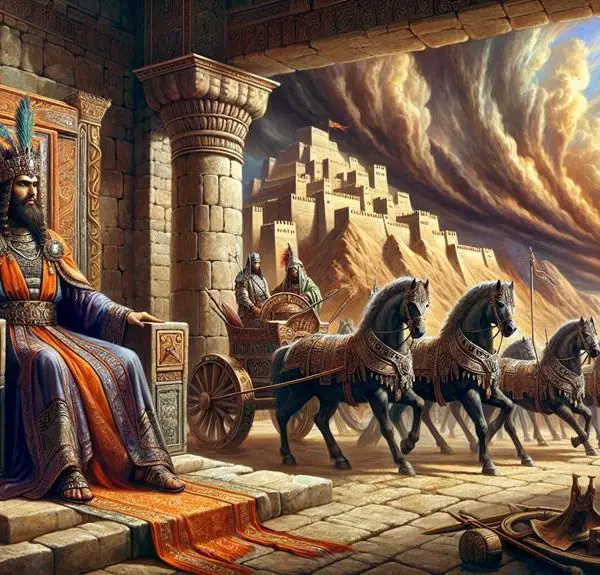

Sign up